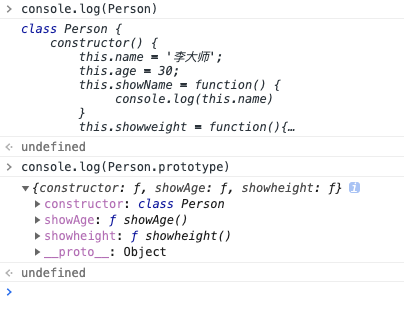ES6中的class的详解
JavaScript输入弱类型的语言,在JS中并没有像Java中的那样的类的概念,以后可能也不会有,ES6中的class实际上也是基于JavaScript中的一个强大的属性,也就是原型属性prototype,由这个属性改良得来的一种语法糖。
JS是基于原型的面向对象语言。原型对象特点就是将自身的属性共享给新对象。这样的写法相对于其它传统面向对象语言来讲,很有一种独树一帜的感脚!虽然强大,但也非常容易让人困惑!
第一部分:那么ES6中的class是怎么工作的呢?
在ES6之前,如果要生成一个对象,那么需要先定义一个构造函数,再使用new操作符来成长这个构造函数的实例对象。
下面是一个构造函数的例子
function Person(name, age) { this.name = name; this.age=age; } Person.prototype.say = function(){ return "我的名字叫" + this.name+"今年"+this.age+"岁了"; } var obj=new Person("李大师",30); //通过构造函数创建对象,必须使new 运算符 console.log(obj.say());//我的名字叫李大师今年30岁了
第二部分:构造函数生成实例对象的过程是这样的:
1.当使用了构造函数,并且new 构造函数(),后台会隐式执行new Object()创建对象;
2.将构造函数的作用域赋给新对象(即new Object()创建出的对象),而函数体内的this就代表new Object()出来的对象。
3.执行构造函数的代码。
4.返回新对象(后台直接返回);
ES6中的class写法就很简洁了
class Person{ //定义了一个名字为Person的类
constructor(name, age){//constructor是一个构造方法,用来接收参数
this.name = name;//this代表的是实例对象
this.age=age;
}
say(){//这是一个类的方法,注意千万不要加上function
return "我的名字叫" + this.name+"今年"+this.age+"岁了";
}
}
var obj=new Person("李大师", 30);
console.log(obj.say());//我的名字叫李大师今年30岁了
第三部分: 那么 class到底是个什么东西呢?
console.log(typeof Person); //function console.log(Person === Person.prototype.constructor); //true
从这两段代码可以看书,其实Person类实质上就是一个函数。类自身指向的就是构造函数。所以可以认为ES6中的类其实就是构造函数的另外一种写法.
类的所有方法都定义在类的prototype属性上面
Person.prototype.addFn=function(){ return "我是通过prototype新增加的方法,名字叫addFn"; } var obj=new Person("李大师",30); console.log(obj.addFn()); //我是通过prototype新增加的方法,名字叫addFn
除此之外,我们还可以通过Object.assign方法来为对象动态的增加方法,
Object.assign(Person.prototype, { getName : function() { return this.name }, getAge : function() { return this.age } }) var obj=new Person("李大师",30); console.log(obj.getName());//李大师 console.log(obj.getAge());//30
第四部分: constructor
constructor 方法时类的构造函数的默认方法,通过new 命令生成实例对象时,自动调用该方法
class Box{ constructor(){ console.log("啦啦啦,今天天气好晴朗");//当实例化对象时该行代码会执行。 } } var obj=new Box(); // 啦啦啦,今天天气好晴朗
constructor方法如果没有显式定义,会隐式生成一个constructor方法。所以即使你没有添加构造函数,构造函数也是存在的。constructor方法默认返回实例对象this,但是也可以指定constructor方法返回一个全新的对象,让返回的实例对象不是该类的实例。
class Desk{ constructor(){ this.xixi="我是一只小小小小鸟!哦"; return this } } class Box{ constructor(){ return new Desk();// 这里没有用this哦,直接返回一个全新的对象 } } var obj=new Box(); console.log(obj.xixi);//我是一只小小小小鸟!哦
constructor 中定义的属性或方法与 constructorz外定义的属性或方法有什么区别呢?
class Person { constructor() { this.name = '李大师'; this.age = 30; this.showName = function() { console.log(this.name) } this.showweight = function(){ console.log(this.weight) } } height = 175; weight=70;
sex = 'man';
salary= 500000; showAge() { console.log(this.age) } showheight(){ console.log(this.height) }
showSex = function(){
console.log(this.sex)
}
showSalary = ()=>{
console.log(this.salary)
} } const person = new Person(); console.log(person.hasOwnProperty('name')); // true console.log(person.hasOwnProperty('name')); // true console.log(person.hasOwnProperty('height')); // true console.log(person.hasOwnProperty('weight')); // true console.log(person.hasOwnProperty('showName')); // true console.log(person.hasOwnProperty('showAge')); // false console.log(person.hasOwnProperty('showheight')); // false console.log(person.hasOwnProperty('showweight')); // true
console.log(person.hasOwnProperty('showSex'));
// true
console.log(person.hasOwnProperty('showSalary'));
// true
从上面的代码我们可以看出
(1)无论是在constructor中,通过this.name = name 这种方式所绑定的属性和方法,最终会在实例对象中体现出来
(2)在constructor外部,通过showSex = function(){} 或者 showSalary = ()=>{} 这种方式绑定的方法,也会在实例对象中体现出来,有图为证

(3)在constructor外部,通过showAge(){} 这种方式绑定的方法,实际上是将方法绑定在了Person.prototype上面,有图为证

那么可以解释一个现象
Person.prototype.showAge()
// undefined // 这个方法实际上输出的是undefined,因为Person.prototype上面并没有age这个属性
一句话来总结:class中,所有的属性,无论是否在contructor中指定,都会绑定到class的实例对象上;class中,通过showAge(){}这种方式绑定的方法,会默认的绑定到class的prototype属性上面去,并不会在class的实例对象上体现,而通过constructor中的this.showName = function(){} 或者constructor外部的 showSex = function(){} 这样的形式绑定的方法,将会绑定到class的实例对象上面去,在prototype上面并不会有体现。
根据上面的原则,我们可以发现,如果要定义一个class,那么对于那些需要在后代中继承的方法,可以通过showAge(){} 这样的形式,绑定到class的prototype属性上去,如果不需要在后代中继承,只需要在实例中使用的方法,就可以通过在constructor中定义,或者通过showSex = ()=>{} 这样的方式,绑定到它的实例对象中区。
第五部分:继承
在ES6中,使用extends关键字来实现继承
class Animal { constructor(){} name = 'animal'; age = 3; showName() { console.log( 'animalName =' + this.name) } showAge = ()=>{ console.log('animalAge = ' + this.age) } } class Dog extends Animal { constructor(){ super() } name='dog'; age=5; fullname = 'Dog'; sex='male'; showSex() { console.log(this.sex) } showName =()=> { console.log('name' + this.name) } showFullName(){ console.log(this.name + this.fullname) } } const dog = new Dog(); dog.showAge(); //animalAge = 5 dog.showName(); // namedog dog.showSex(); // male delete dog.showName dog.showName() // animalName =dog
我们可以发现,如果一个class的方法并不是定义在prototype方法上,而是像通过赋值一样showName = ()=>{} 这种方式,那么如果delete 了 实例对象上的属性,这个属性就会消失,再执行这个方法,就会向上访问它的原型 dog.__proto__ 也就是Dog.prototype上去查找,但是Dog.prototype上面也是没有showName属性的,那么它只好向上查找,因为Dog是Animal的子类,Dog.prototype.__proto__ === Animal.prototype, Animal.prototype上面是有showName属性的,那么可以得到最后一个结论,delete dog.showName之后 ,dog.showName() 会输出 animaleName =dog






 浙公网安备 33010602011771号
浙公网安备 33010602011771号